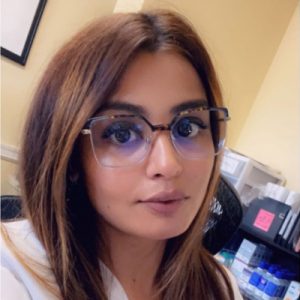Is your child’s myopia worsening?
Myopia, also known as nearsightedness or shortsightedness, is the inability to see distant images or objects clearly— making it difficult to see road signs, the television, or a clock on the wall.
- Myopia affects millions of children and adults, worldwide.
- Myopia affects up to 40% of people by age 17.
Myopia occurs when the eye grows too long (axial length), or the cornea and/or eye lens are too curved, relative to the length of the eyeball. A myopic eye focuses images in front of the retina, instead of directly on the retina, resulting in blurry distant vision.
Myopia can be corrected using corrective eyeglasses or contact lenses and is noted on the eye doctor’s optical prescription by a negative sign, such as -1.00 or -2.25.
What causes myopia?
Myopia is often hereditary, and typically begins in childhood and plateaus by the age of 20.
Myopia may also develop in adulthood as a result of environmental factors or health problems:
- Excessive amounts of near-vision work may cause a false or “pseudo” myopia. Blurred distance vision in this case occurs from stress on the eyes’ focusing skills after prolonged near work tasks. Clear vision typically returns after rest. Constant visual stress may lead to myopia.
- Myopia may also be caused by diabetes, or may be an early sign of a developing cataract.
- Night myopia, in which blurred distance vision is only experienced at night, may be caused by a focusing difficulty in low light.
Signs and symptoms of myopia
- Blurry distance vision
- Squinting when driving or watching TV
- Sitting at close proximity to the TV or computer screen
- Holding books close to the eyes
How is myopia diagnosed?
Myopia is diagnosed during a comprehensive eye exam using the following tests:
Visual acuity: During this test, you will be asked to identify letters on a distance chart.
Retinoscopy: This is a technique used to obtain an objective measurement of a refractive error. Your eye doctor will use a retinoscope to shine light into your eye and observe the reflection or reflex, off of your retina.
Tests of eye focusing abilities include:
-
- Assessing your ability to maintain clear vision when switching focus from near to distant objects— a necessary skill for driving.
- Assessing your ability to maintain clear vision for an extended period of time— reading a book or working on a computer.
If you are diagnosed with myopia, your eye doctor will give you a prescription for corrective eyeglasses or contact lenses.
Can myopia cause serious eye problems?
Yes.
In most cases, low levels of myopia, generally below -3.00, present little risk, if any, to your ocular health. These lower levels of myopia present more of an inconvenience than a health risk, as you will need to get used to wearing glasses or contact lenses to see clearly.
However, in about 10 percent of people with myopia, the condition worsens in severity. Sometimes myopia can worsen to the point that it is considered a degenerative disorder, which could cause significant or total total loss of vision.
Myopia is a serious condition that can increase the risk of developing ocular diseases later in life, such as cataracts, glaucoma, or retinal detachment.
The good news is that with regular eye exams, vision therapy, and myopia management, you can regain clear vision— while decreasing your risk of developing an ocular disease.
What causes myopia to worsen?
The main cause of myopia progression is an increase in the eye’s overall length, this also known as the eye’s axial length.
Many factors can contribute to increasing the eye’s overall length, such as:
- Wearing glasses all day, everyday can actually cause myopia to worsen. If you have low myopia, glasses should only be worn sometimes, for activities such as driving, watching TV, or playing sports. Glasses for low myopia are not needed for near vision tasks, such as reading, writing, or texting.
- Wearing glasses with full correction may also contribute to myopia progression. For example, if you have a refractive error of -2.50 diopter, some eye doctors will prescribe an under corrected lens of -2.25 or -2.00 diopter. Under correction is optimal because prescribing the full optical prescription of -2.50, might provide significantly clearer vision, but may contribute to myopia to worsening over time.
- Natural eye growth causes myopia to worsen as the eye grows and changes shape. Myopia tends to progress and worsen through the teenage years, and plateau by age 20— when the eye stops growing.
- Genetics contribute to myopia progression, especially if both parents are myopic.
- Spending limited time outdoors has been shown by research to cause myopia progression, mainly if you spend less than 1-2 hours outside per day. Spending time outdoors is essential as it gives the eye muscles a chance to relax and take a break from constant focusing activities.
- Prolonged use of digital devices has been linked to myopia progression. We are all guilty of spending many hours per day on all different types of devices— smartphones, tablets, computers, etc. Prolonged usage of digital devices can place excessive stress on the focusing skills, which can lead to eyestrain and myopia progression.
- Prolonged near vision tasks such as reading, writing, computer use, smartphone use, etc. has been shown to be a possible cause of myopia progression.
Is it possible to prevent myopia from worsening?
Yes.
There are now specifically trained optometrists in the field of Myopia Management that can provide effective treatments.
Research has shown that certain lifestyle habits can influence myopia progression. For example, the amount of time we spend in front of televisions, computers, cellphones, and other digital devices, can have damaging effects on our eyes.
It is important to follow certain guidelines that can help to reduce these effects:
- Limit the amount of time you spend on your phone.
- Take frequent breaks from screen time— at least every hour.
- Place your screen 18-24 inches away from your face.
- Adjust screen brightness and contrast to make it more comfortable.
- Avoid screen use where a glare can affect vision.
- Blink frequently to keep your eyes moist.
For all near vision tasks such as reading, writing, texting, and computer use, follow the 20-20-20 rule— every 20 minutes, look 20 feet away, for 20 seconds.
Spend time outdoors
Slowing the progression of myopia has also been associated with spending time outdoors— eye doctors recommend 60-80 minutes outside every day.
Spending time outdoors allows natural light to enter the eye and gives the eye muscles a chance to relax and focus on distant objects, while encouraging healthy lifestyle habits.
How is myopia treated?
Eyeglasses are the most common choice for the purpose of regaining clear distance vision. Full time wear will be necessary if you have a higher prescription. If you have a lower prescription, you may only need to wear your glasses for activities that require distance vision, such as driving or watching TV.
Single-vision lenses are generally prescribed for clear vision at all distances.
Bifocal or multifocal lenses may be required for patients over age 40, or for myopia caused by focusing difficulties. These lenses provide different optical powers throughout the lens to enable clear vision for near and distant images.
Contact lenses provide clear vision at all distances, with a wider field of view, as compared to eyeglasses. Many people prefer to wear contacts for aesthetic or social reasons, and for ease of comfort when playing sports. However, contact lenses are placed directly on the eyes, and therefore require proper hygiene to maintain eye health.
Laser procedures such as LASIK (laser in situ keratomileusis) or PRK (photorefractive keratectomy) can provide clear vision by permanently removing corneal tissue to improve the eye’s focusing abilities.
Other refractive surgery procedures, called phakic intraocular lens implant, and clear lens extraction with intraocular lens implantation, involve placing an implant in front of, or in place of the natural lens, for vision correction. These procedures are generally performed on people with high myopia who cannot undergo laser surgery.
Contact a vision therapy eye doctor to diagnose and treat your myopia, so that you can have clear vision.
SEE RELATED: Myopia Management: The Alarming Rise in Global Prevalence
What is myopia management?
Myopia management is a treatment program to keep the level of myopia as low as possible, and reduce your risk of developing a serious sight-threatening eye disease.
Myopia management has shown to decrease myopia progression by up to 78 percent.
Myopia management can involve the use of eyeglasses, contact lenses, and eye drops— all scientifically proven to aid in the control of myopia progression.
A closer look at myopia management
Eyeglasses
Eyeglasses are a popular choice as they are easy and comfortable to wear, and provide clear vision. Bifocal and multifocal lenses contain different lens powers throughout the lens, and enable clear vision at all distances. The specific power for near vision reduces stress on the eyes and possibly the progression of myopia.
Contact lenses
Contact lenses provide clear vision at all distances, with a wider field of view as compared to eyeglasses. A multifocal contact lens works similar to eyeglasses to improve distance vision acuity, while simultaneously reducing the stress on the eyes for reading and other near vision tasks. This can consequently reduce myopia progression.
Atropine eye drops
These medicated eye drops can be used to dilate the eye’s pupils during an eye exam, but have also been proven to reduce myopia progression. A very low dose of this eye drop is placed in the lower eyelid every day.
Side effects may include blurry near vision or light sensitivity. You will still need to wear their regular glasses or contacts during the day, but the eye drops can assist in slowing down the worsening myopia.
Orthokeratology (Ortho-k)/ Corneal refractive therapy (CRT)
Ortho-k reduces myopia progression through the use of specialized rigid contact lenses that reshape the cornea, the front outer surface of the eye. The contacts are worn at night only and work to flatten the cornea, thereby changing the way light is focused on the retina at the back of the eye.
These contact lenses are inserted before bedtime, and are generally only worn while you sleep. The goal of Ortho-k is to provides clear vision for the whole day, thereby eliminating the need for wearing glasses or contacts during the day.
Can vision therapy control myopia progression?
Vision therapy is an appropriate and effective treatment for those who have acquired myopia as a result of reduced eye focusing skills. Vision therapy involves a personalized program that trains the visual system, including the eye-brain connection, to work more efficiently— thereby improving focusing abilities. People who have reduced focusing skills, have a greater risk of developing progressive myopia.
LEARN MORE: Guide to Myopia Management
If you have symptoms of myopia, schedule an eye appointment with a vision therapy eye doctor as soon as possible to improve your clarity of vision and avoid complications of worsening myopia.










